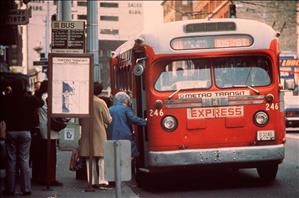On January 1, 1973, the Seattle Transit System is ushered out of existence and Metro Transit is ushered in. This comes after a September 19, 1972, vote authorizing the Municipality of Metropolitan Seattle (better known as Metro) to take over both the existing transit systems in King County: the Seattle Transit System within the Seattle city limits and the privately-owned Metropolitan Transit Corporation (an entirely different entity than Metro) in the suburbs. In the months following the vote, Metro negotiated a purchase price for the two bus systems and acquired both fleets of buses. Metro bought new uniforms for the drivers and slapped new Metro Transit stickers on the sides of the buses. Despite the limited transition time, all goes smoothly on the first day of operations. For the first time in its history, King County's transit operations are united under one system.
Fifth Attempt Succeeds
This was not the first time that Metro had proposed to take over the much-beleaguered transit systems in King County. When civic leaders first came up with the concept of the Municipality of Metropolitan Seattle in 1958, their initial plan was for this new governmental entity, governed by a board consisting of elected city and county officials, to take over six basic services for the entire Seattle metropolitan area: sewage treatment, solid waste disposal, water supply, regional parks, comprehensive land-use planning, and mass transportation. Voters rejected the plan.
Metro backers came back later in 1958 with a proposal that concentrated only on sewage treatment and cleaning up Lake Washington. Voters passed this measure in the fall of 1958. Metro was born -- but without any mass-transit component.
The Seattle Transit System -- which had begun as the Seattle Municipal Railway back in 1919 -- continued to operate Seattle's bus and trackless trolley system, but it was bleeding money and ridership. In the suburbs, the privately owned Metropolitan Transit Corporation was in even worse shape. In 1962, Metro went back to voters with a proposal to take over all of the county's transit operations. Voters once again overwhelmingly rejected it.
Then in 1968 Metro proposed its most ambitious transit plan yet, as part of a huge package of civic improvements called Forward Thrust that also included funding for the Kingdome, Seattle Aquarium, parks, roads, and more. The transit plan envisioned a 45-mile rail system stretching south to Renton and east to Bellevue (one that bore a striking resemblance to the Sound Transit plan that would be approved more than 40 years later). In February 1968 voters once again weighed in against mass transit. They shot down the transit component of Forward Thrust even as they approved other parts of the package. This was a stunning defeat for transit, and Metro vowed to try again. It brought the transit measure back to voters in 1970, and they rejected it by an even bigger margin.
In 1972 Metro planners came up with a scaled-down plan that echoed that original 1958 concept. Instead of proposing a multimillion-dollar rail system, they proposed buying out the Seattle Transit System and the Metropolitan Transit Corporation, and creating one countywide all-bus transit system. This time Metro officials were more optimistic about the outcome, for several reasons. The two old bus systems were limping along financially and King County residents were increasingly open to the idea of improving mass transit as an alternative to simply building more freeways. Also, crucially, Metro leaders planned to fund the system mostly through a sales tax, not a property tax, which meant it would require only 50 percent voter approval, not the 60 percent that previous measures had required and failed to meet.
Nevertheless, even Metro officials were somewhat startled when the measure passed with a whopping 59 percent majority on September 19, 1972. "The ant woke up one day and discovered it had swallowed an elephant," said Chuck Collins, who would eventually become the Metro Transit director (Crowley, "Routes: An Interpretive History ...," 70). Metro had only 248 employees and was preparing to take over a Seattle Transit system with more than 1,000 workers, plus the smaller suburban system.
Metro Takes Over
Metro had only 103 days to complete the takeover, scheduled to take place at the beginning of 1973. It negotiated the purchase of Seattle Transit's assets for $6.5 million and Metropolitan Transit's assets for $1.2 million. Metro also negotiated new contracts with the drivers and issued new uniforms. Before dawn on the morning of New Year's Day, Metro Director Charles V. "Tom" Gibbs and his wife went out to the bus barns to greet the drivers and nervously await developments on the first day. Fortunately, buses pulled out on time, the system ran well, and Gibbs breathed a sigh of relief.
Passengers themselves noticed several differences. They would need to carry exact change, because Metro drivers -- unlike the former Metropolitan Transit Corporation drivers -- would not make change. Riders also had to adjust to a few route changes and schedule changes, mostly outside Seattle. Finally, a new 20-cent basic fare was inaugurated -- cheaper than some existing Seattle fares, and cheaper by half than most Metropolitan Transit Corporation fares.
January 1, 1973, was a low-traffic holiday and a relatively easy opening day. Gibbs said, "Frankly, I'm very pleased with the enthusiasm of the drivers. Obviously time will be required for everyone to get used to the new fares" (Lane, "Out with the Old ..."). The transition proved to be a bit rougher in ensuing weeks, especially on the suburban routes. Yet Metro Transit would prove to be a resounding long-term success. Metro Transit would more than double its ridership within seven years, reversing decades of Seattle-area transit decline.
In 1994, Metro merged with King County. It continues to operate King County's bus system, now under the name King County Metro Transit.

